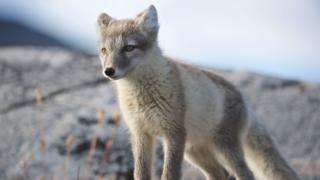![]() By News from Elsewhere…
By News from Elsewhere…
…as found by BBC Monitoring
 Image copyright
Image copyright
Universal Images Group/Getty Images
Arctic foxes learn to fend for themselves early on
A young Arctic fox has walked across the ice from Norway’s Svalbard islands to northern Canada in an epic journey, covering 3,506 km (2,176 miles) in 76 days.
“The fox’s journey has left scientists speechless,” according to Greenland’s Sermitsiaq newspaper.
Researchers at Norway’s Polar Institute fitted the young female with a GPS tracking device and freed her into the wild in late March last year on the east coast of Spitsbergen, the Svalbard archipelago’s main island.
The fox was under a year old when she set off west in search of food, reaching Greenland just 21 days later – a journey of 1,512 km – before trudging forward on the second leg of her trek.
She was tracked to Canada’s Ellesmere Island, nearly 2,000 km further, just 76 days after leaving Svalbard.
‘Couldn’t believe our eyes’
What amazed the researchers was not so much the length of the journey as the speed with which the fox had covered it – averaging just over 46 km (28.5 miles) a day and sometimes reaching 155 km.
“We couldn’t believe our eyes at first. We thought perhaps it was dead, or had been carried there on a boat, but there were no boats in the area. We were quite thunderstruck,” Eva Fuglei of the Polar Institute told Norway’s NRK public broadcaster.
No fox has been recorded to travel that far that fast before.
You might also like:
Eva Fuglei has been working with Arnaud Tarroux of the Norwegian Institute for Nature Research to track how the foxes cope with the dramatic changes of the Arctic seasons.
“There’s enough food in the summer, but it gets difficult in winter. This is when the Arctic fox often migrates to other geographical areas to find food to survive. But this fox went much further than most others we’ve tracked before – it just shows the exceptional capacity of this little creature,” she says.
Thick fur provides excellent protection against the elements
The Polar Institute produced a graph that shows how the fox made two breaks in her journey across northern Greenland.
The scientists think she may have curled up in the snow to sit out bad weather, which is perfectly possible with such thick protective fur, or else found a source of food like seabirds in an open channel of water.
‘Shrinking ice pack’
We will never know what the little fox gets up to in Canada, as her transmitter stopped working in February, the Polar Institute reports.
But she will definitely have to change her eating habits – “Ellesmere Island foxes live largely on lemmings, rather than the mainly-marine diet of Svalbard,” according to Eva Fuglei.
The shrinking of the polar ice pack is having an impact on Arctic foxes – they can no longer visit Iceland, for example, and in due course the population in Svalbard could become completely isolated.
But Eva Fuglei told NRK that there is still hope, as “higher temperatures could mean more Svalbard reindeer, and the foxes scavenge off their carcasses”.
Image copyright
DeAgostini/Getty Images
Svalbard reindeer are a lifeline for the Arctic fox
Reporting by Matilda Welin and Martin Morgan
Next story: North Macedonia holds its first Pride parade
Use #NewsfromElsewhere to stay up-to-date with our reports via Twitter.
